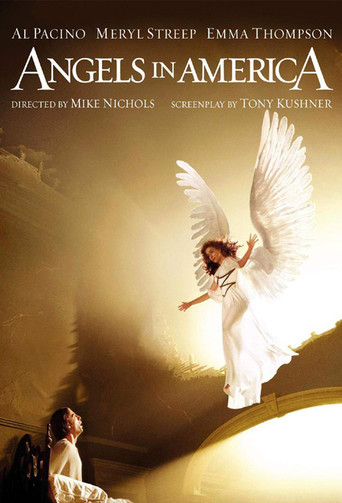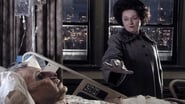Alex Pettigrew
The mini-series Angels in America is a story of epic proportions, the playwright re-written into a screenplay by the original writer Tony Kushner, has multiple stories connecting through the deadly disease of AIDS, takes them on a journey of discovery through hallucinations of angels. The entire cast give a stunning performance, with actors like Meryl Streep, Jeffrey Wright, Justin Kirk and Emma Thompson playing up to two to three roles, giving the film that extra little bit of magic. Each character has a story that we follow through out, with every character relating in someway to sexuality, following confusion, acceptance and frustration. On top of it all is the wonderful score by Thomas Newman, who scored such films as "American Beauty" and "The Shawshank Redemption", Newman takes you on a magical flying carpet ride through a world of almost cinema, giving the television series a strong beating heart that will stay with you for a long time.The story is in 6 chapters rolled over in two 3 hour episodes, which gives the series a triumphant legacy, as a part of HBO's outstanding library of film, television and documentaries. This is truly a major milestone in cinematic history and should be recognized for it sheer emotion and storytelling.
namashi_1
'Angels in America' is amongst the moving & beautiful Mini-Series from the early 2000's. Adapted from the Pulitzer Prize winning play of the same name by Tony Kushner, This Multiple-Award-Winning Mini-Series, is simply unmissable. Also, the performances, are top-notch!Set in 1985, the film has at its core the story of two couples whose relationships dissolve amidst the backdrop of Reagan era politics, the spreading AIDS epidemic and a rapidly changing social and political climate. 'Angels in America' was the most watched made-for-cable movie in 2003, and garnered much critical acclaim. And it deserves all the acclaim. Here's a story that is about, love, hate, believe & forgiveness. 'Angels In America' unfolds with magic and each chapter, is interesting & very moving. The characters, some taken from real-life, are diverse, yet very connectible. Even though depressing at times, Tony Kushner's Writing is so emotionally engaging, it leaves an haunting impact on it's viewer. Mike Nichols Directs this Marvelous Story, most amazingly. Cinematography by Stephen Goldblatt is excellent. Editing by John Bloom & Antonia Van Drimmelen, is sharp. Art Design is pitch-perfect. Performance-Wise: Al Pacino as Roy Cohn, is sensational. Meryl Streep portrays 3 different characters, with unmatchable ease. Streep, delivers a performance, that truly can be considered, as an actor-study. Patrick Wilson is absolutely terrific, while Justin Kirk is nearly flawless. Mary-Louise Parker is superb. She delivers the performance of her career. Ben Shenkman is quite natural. Emma Thompson & Jeffrey Wright, who also appear in multiple roles, are first-rate. James Cromwell is impressive in a small cameo. On the whole, 'Angels in America' is a Masterpiece! An Unmissable Story! Strongly Recommended!
angelofvic
One thing to remember if you're thinking about watching this -- and it is one of the gay classics -- is that it has uneven patches. But when you're just about fed up with a patch that is senseless, tedious, or irritating, suddenly it gets good again. And of course in totality, the whole thing gels and feels complete and meaningful and uplifting.One great thing about the film is that it encompasses a wide variety of characters. It's not confined to a tiny group of gay friends, one or more of whom might get sick. In this regard, it succeeds much better than even "Rent" does.So do take a look at it if you're interested in gay-related cinema or AIDS-related themes. Just realize that, however, it probably won't be quite what you expected. But, in that, it might actually turn out to be better than you expected!
jcduffy
As I suspect is true of most of the people who assigned this film ten stars, I am a huge fan—yea, verily, a devotee—of the *play* "Angels in America." When I heard that HBO was turning it into a miniseries, I was duly thrilled, and that excitement carried me through my first viewing of the broadcast with only a minor sense of letdown. I recently re-watched the film over several evenings, and with the added distance of several years, my disappointment in the film is stronger. The play deserved a better screen adaptation than this.The acting, I'm pleased to say, isn't one of the major problems. With one exception, the cast do a fantastic job. I don't have the space to single out every actor for the praise they deserve, but I do have to make special mention of Jeffrey Wright's Belize (Ma cherie bichette!) and Meryl Streep's Ethel Rosenberg. The one weak link in this cast is Emma Thompson. She's reasonably believable as the Angel, though hardly an obvious choice. But she's too British to pull off Emily, the Italian American nurse (she doesn't even remember to keep up the accent), and she's too posh to play the psychotic homeless woman (again, accent). If you're going to do the actors-playing-multiple-roles thing, then Thompson needs to work in all three roles.The film's biggest problems lie in the directing and possibly the editing. The pacing is spotty, especially in Part 1. Some scenes play out too slowly: for example, Roy Cohn's first scene, with the phone, which isn't as frenetic as it's supposed to be; or the "quartet" scene, where we watch the two couples—Harper and Joe, Prior and Louis—in overlapping crisis. Other scenes play out too fast: the first meeting of Joe and Louis in the washroom, for instance, which moves too quickly to build up much sexual tension between them.There are missteps in tone right from the beginning of the film. The rabbi's opening monologue is too light, too feel-good, too Hallmark channel or Steven Spielberg. And the confessional scene between Louis and the rabbi shortly afterward, which works on a stage with minimal scenery, becomes unbelievable when it's placed at the cemetery entrance, with people passing behind and a whole row of rabbis listening in—and the coffin, the central presence in this scene as originally written because it symbolizes Prior's mortality and reminds us that Louis is a person who abandons people who have claims on his love, nowhere to be seen.But the biggest problems with tone surround the Angel's appearances. Kushner warns in his playwright's notes that unless "the director and designers invent great, full-blooded stage magic," the results will be "disappointing" and "ineffectual." Now, on a stage, in a live theater, the special effects used in this film would have more than fit the bill for "great, full-blooded stage magic." But on screen, in the age of CGI, the special effects didn't come across as that spectacular. A major failing here—paradoxically—is Nichols's insistence on using wide shot to show us the scale of what they created. Again, I'm sure that live, on set, the staging of the Angel's appearances looked amazing. But on screen, it just looks like Emma Thompson hanging from a cable way up in the air (and wriggling around in a funny way) in a room with abnormally tall ceilings. Sci-fi has spoiled us, Nichols. Unless you have the budget to compete with the scale of a CGI blockbuster, don't try. I'm willing to bet money that designing special effects on a smaller scale, relying more heavily on close-ups to fill our vision with wonder, would have produced more spectacular results. This would have been especially important in the wrestling scene, which is supposed to be deathly serious but was so over-the-top that it actually ended up coming across as slapstick.I have a similar complaint regarding the use of sex in the Angel's appearances. The Angel wasn't a convincing erotic presence because we were shown too much. Wide shots of the Angel and Prior copulating in mid-air wreathed in fire, or the Angel and Hannah locking lips and thrashing around amid fireworks, weren't as impressive as I'm sure they sounded on paper. It just looked, to borrow a line from the script, ungainly. Again, close-ups—glimpses of naked flesh, eyes and mouths in ecstasy—would have been more effective. The close-in shot of Hannah falling back onto the bed in post-coital bliss was more emotionally powerful, and a more striking piece of stage magic, than the wide shot that preceded it.Some final remarks about Kushner's rewrites for the screenplay: I regret the loss of the magic realist scene in the Mormon Visitors Center, between Harper and Prior—but I'm prepared to sigh and say, "Well, you can't preserve everything, that's why the movie's never as good as the original." The additional scene between Hannah and Joe near the end of the movie, at the entrance to the subway, was a worthy addition, an excellent way to provide more closure for Joe's storyline. Throughout the movie, religion was more prominent than it had been in the play: Hare Krishnas chanting in the street, the gospel choir at Belize's friend's funeral, the apparently Amish choir outside the subway. That added a nice dimension to the work. I am baffled, though, by the unhelpful additions to the scene between Hannah and Joe at the Visitors Center, and that trite line about "Hold to what you believe" is...an embarrassing stain.I'm probably coming across as a perfectionist. But "Angels in America" is an outstanding work that deserves perfection. I've seen films so good I'm prepared to hail them as perfect. I would really have liked this to be one of them, but it wasn't.








